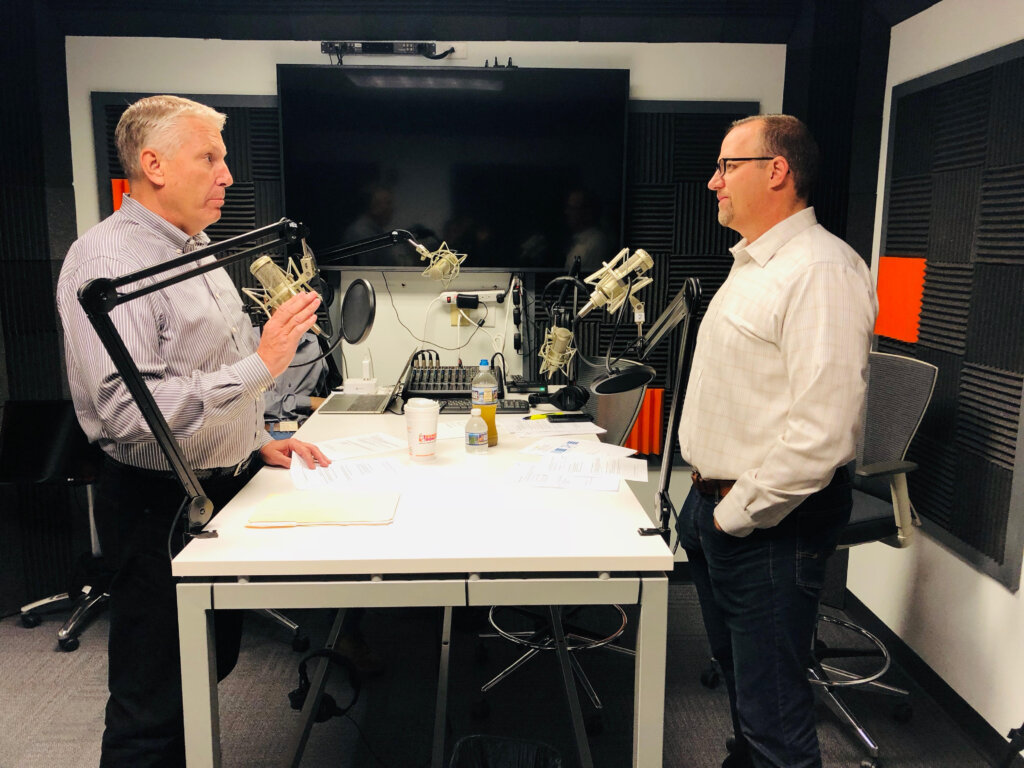Maxwell Executive Leadership Podcast #25: Where Have All the New Health Club Members Gone? Staying the Course When the Going Gets Tough

Statistics show that 90% of people that joined health clubs in January are out by the end of March. The same thing happens with leadership. We all have great intentions at the beginning of the year, but eventually we start making excuses when life gets in the way. In Episode #25 of our Executive Leadership Podcast, we share four key things that leaders can do to sustain their team after the initial excitement of starting a new year or a new project, and how to keep the momentum going all year long.
Listen to all podcasts in this series and subscribe to new episodes on iTunes– or Google Play.
Read the transcript below:
Welcome to the John Maxwell Company Executive Leadership Podcast where our goal is to help you increase your level of influence, increase your reputation as a leader, and increase your ability to fully engage your team to drive remarkable results. Hi, I’m Perry Holley, a John Maxwell facilitator and coach and I’m Chris Goede, Vice President of The John Maxwell Company. Welcome and thank you for joining.
So Chris, today’s topic is “Where Have All the New Health Club Members Gone?” and it could be subtitled, “Staying the Course When the Going Gets Tough”. Of course, we’re referring to the fact that a lot of people will join health clubs and they have great intentions at the beginning of a new year. They stop going a few months later or a few weeks later. Tell me how this compares to leadership.
Well, I always love the titles that you’ve come up with. And, when I saw this one I thought, man, you know, Perry’s been reading my emails before. Through my years of playing sports and different things, I’m actively still try to work out. And it is so true, man, that when you look at the parking lots at the gyms, you know, January, February, they’re full and then they begin to kind of tail off the rest of the year. And, so I know the statistics show that 90 percent of people that joined the health clubs in January are out within three months by the end of March, and we all have good intentions, but then life gets in the way, right? And we begin to sell ourselves or make excuses on why we should not be doing what we’re doing. And I think good intentions are not enough to sustain us and what we need to accomplish, what we need to set goals for ourselves as leaders, but as our team as well. And there’s a great quote by Andy Stanley where he says direction not intention determines destination. Yeah. So always thinking about, I have great intentions, but am I actually on the path leading to where I want to go? And so Andy has a great message there.
I should ask you, you’ve had your Peloton now for like six months. Are you still on the course? I am. Okay. I am checking in, stick with that. So, we always like to really relate these conversations and our leadership discussion on The 5 Levels of Leadership. So, I see this as a Level 3 production. Producing results as a team is an issue for the leader. Would you agree with that?
I would absolutely. I think, you know, when it comes to Level 3, we talk about the production, right? John says it’s what you have done for the organization not only as an individual contributor but what you are doing in and through your team or your teams. And I think as a leader, we all set each year with goals and where we’re going and what we’re going to do and everybody gets that kind of reenergized focus. And as leaders we want to create momentum. And John talks a lot about at this level where as a leader, this is where your credibility is built, right? Like, we can all understand that at Level 1, it’s given to you, Level 2, we’re going to build relationships and we’re going to connect with people. But at the end of the day, if we’re not at Level 3, none of us have jobs.
And, so we want to follow people that are getting things done and you have this, you know, this credibility. So, we all have these great plans at the beginning of the year. We create these great scorecards that the team’s going to kind of watch. We create new systems and it’s our job to make sure that we’re creating that law, the Big Mo as he says, and keep it going. And the thing I would say here when it comes from a production standpoint, make sure that you’re not trying to change too many things at one time, you know, what is the one thing that we need to be focusing on in order to keep their attention span and not lose them 90 days into the new scorecard, the new plan, the new vision, whatever it might be.
Well that actually relates perfectly to when I was looking at, so why do people leave the health club after starting with great intentions in January? He said surveys that we’re taking and I think it actually pertains to why our teams may may lose that momentum or stopped producing results. Is that a number one reason was they just have too much to do in their life. They just have too many activities going on. Number two, the results take too long and that we think about in the health club, I’ve been here for three weeks. I haven’t lost any weight what’s going on with that? But, people want instant gratification and that’s a big challenge in business results, as well. And number three, the mountain just seems too high to climb. That was straight from the survey that this is, I need to lose a lot of weight and it’s not happening fast enough and I need to stop. So kind of relate that to the business challenge of a Level 3 leader.
Yeah. It’s funny because when I was looking over this and some of those points that you brought up, I thought of three things that all start with an S, right? How do we as leaders simplify the message? Oftentimes, when you talk about there’s too much to do or people get confused and when you do that you have lack of movement, lack of momentum. So as leaders, how do we simplify the message? Secondly, we need to go after small winds, and then verbally communicate and reward the team in those small wins. I know for myself personally, if I look at what our annual goal is, I’ll get stressed out. I think we’ll never going to get there.
And so how do you begin to back into what the end state is and then small wins and then, I wrote down this just because it started with an S probably, speed bumps, right? Know that you guys are going to attack and go over speed bumps along the way versus climbing this big mountain. And, so I think, if you think about it from those three S’s as you’re leading your team, your department, whatever it might be, it may help you overcome some of those challenges for people to quit. I love that. Let’s see if we can relate that to you and I were discussing this and the really four things that we think that a leader could do to help sustain the team after that initial excitement of starting a new year or a new project, setting a new goal, what those things are.
But I think we wrote down, number one would be to set a clear goal that everybody knows where we’re going. The big picture. Yeah. It goes right back into the simplification, right? How are we going to simplify the message? I think leaders often, you know, think that the goal is clear to the team because it’s clear to themselves. In the past, we’ve talked about the intent versus perception, right? My intent is to come into this meeting and set a clear path, but that may not be the way that it’s perceived in. And John talks about that even just from a vision standpoint, simplify the message, but more often than not, repeat it. That’s what I learned from him, I always thought that if I already said the vision, didn’t you get it? Well, there’s so much other stuff going on at every chance you get to repeat that vision to make sure people hear it from you, from your heart. This is what we’re trying to accomplish. Just solidifies it more and more.
Our CEO, Mark Cole, starts all of our executive meetings off with kind of recasting that. And, he smiles and he’s like, you guys know where I’m going, but I just haven’t. I have to share it. I think also as you clearly communicate the message, you know repeatedly, but you do it clearly, it allows your employees to perform at the level that they need to. And everybody’s on the same page. We talk a lot about on this podcast, how do we increase employee engagement? And I think that’s one of the things that would do that. My final thought here is I kind of wrote down this little phrase, fill in the gap for them. And, I think when we have gaps, we tend to, as people, leaders and you know, as a team member, we fill in those gaps of unknowns with a narrative that is relevant to us. And oftentimes if we don’t have that gap filled, we fill in the narrative in a negative way, not a positive way. And, so if my leader is communicating to me one thing and we’re going in this direction and there’s a gap there, my mind is going to negatively fill in the gap or make an assumption about a certain situation versus positively. And, so the more we can communicate and simplify the message so that those gaps are closed, I think the better we’ll be.
So number two that we talked about, Chris was establishing milestones or KPIs that help people really reach for that big goal, those key performance indicators. How do I know I’m making progress on that goal? Well, you know, the team has to know that you guys are making progress. That’s kinda back to I talked about the speed bumps, right?The more success they feel or you feel it increases morale back to this engagement thing. Right? And, so how do we frequently, with smaller milestones, reward them with that, have conversations about that, increase the morale? And I mentioned just a minute ago, the biggest thing for me is if I look at the end state, it overwhelms me. And, so how do I look at the end state and then back into it to where, hey look, this is what is going to happen this week. And when we achieve that this week, we’re going to celebrate that on Friday the end of the business day. That’s the health club January challenge. I know I have a long way to go the mountain is big, but what are the small steps to get there?
Number three we said was it helps if you do it together, kind of collaboration. I noticed in a health challenge myself and trying to get in shape and doing it with my wife is accountability and others. You and I have talked about it and asking each other, how are you doing? Checking in that little extra accountability there. Well, not only you and I, but you just made it public to all of our listeners that I have a Peloton in six months ago, I bought it. So, now I’m sure I might be getting emails to find out if I’m still doing it. So, I appreciate that. I’ll get you back later. You know, we have to do it together. John talks about the fact that, man, listen, the last thing we want to be doing is going on this journey by ourselves, right? It’s a lonely place to be. And so we have to have accountability and here’s the thing, I think it’s incredible not only to have the leader to team member accountability, but to have peer to peer accountability and give the team permission to do this with each other so that it’s actually something that the team works on a together and not only for what they do, but what they say.
One of the things that really bothers me a lot and I see a drop in employee engagement is a lot of things that are said and talked about that really shouldn’t be said and talked about in the workplace. And so give them that peer to peer accountability. You know, a lot of people don’t like to hold each other accountable. One of the things that I tell myself because I have a natural Level 2 bent that sometimes that’s hard for me, is that if I don’t do that, I’m not necessarily showing love for that other person, right? If I’m just allowing it to happen. And then the final comment I’d make here about accountability, and this is one of the things that we do at The John Maxwell Company is on our team, we track the progress against our goals openly throughout the whole team. Each team knows where the other team is. There’s a little bit of a competitive spirit in that, but in addition to that, you know, at the end of the day, I don’t want to at Friday show a report that I’m continually not meeting the expectations of my goal when, you know, the team over there is counting on me. So, you know, we do that and even in 2019 for The John Maxwell Company, you know, we literally have things in place to where on a weekly basis there’s going to be peer to peer accountability on what we’re trying to accomplish as a team. I think that does everybody good to be able to hold each other accountable when it comes to production. Yeah. Good.
And then number four of our ways to sustain a team after the initial excitement is gone, is to be clear about how to handle setbacks or failure. I think about it in the health club. If you know, I’m working hard, but I do go home and have that doughnut, do I just give up and just let it all slide away or can I recover from that? Yeah. I think this is a great part of our podcast today because really failures is a word that’s talked about a lot both personally and professionally. And John has written a ton of lessons and obviously a couple of books on it about allowing our people to fail forward, right? Allowing them to fail instead of just completely quitting, right? You go home, you have the doughnut and you’re like, I’m out. You don’t show back up or you order another dozen Krispy Kreme donuts. My thing here is, and some of the things that I’ve learned from John that there’s a couple things I want to share. Three things that I wrote down. Number one, don’t count your losses. Count the lessons learned from those failures, right? And that would serve you well. I think also lean into failure individually, as well as a team. Don’t hide it. Everybody knows, right? I mean, if they’re close enough to you, everybody knows, so lean into a don’t hide it. And then finally, we’ve talked a lot about this today. Make sure you’re celebrating the successes of what the individual, the team is doing and eliminate the failures, you know, we still want to make sure that we bring those up. So in closing, here’s kind of my thought is ultimately we want the best for ourselves and others and I think we can do that by being clear, have a simple message, be clear, have smaller milestones, do it together and hold each other accountable and lean into failure. That’s terrific.
Also, as a reminder, if you would like to learn more about the 5 Levels of Leadership or perhaps bring a 5 Levels of Leadership Workshop to your organization, please go to JohnMaxwellCompany.com/podcasts. We would also welcome any questions or thoughts you may have about leadership on that site that Perry and I will be able to answer in future podcasts for you. Thank you for joining us. This has been the John Maxwell Company Executive Leadership Podcast.












Be the first to comment on "Maxwell Executive Leadership Podcast #25: Where Have All the New Health Club Members Gone? Staying the Course When the Going Gets Tough"